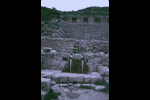|
 Shrine-Fortress Saxsayhuaman, Cuzco, Peru
Shrine-Fortress Saxsayhuaman, Cuzco, Peru
"The Inca capital, Cuzco, was largely destroyed during the
Spanish conquest and subsequent colonial period. Thus,
most of what is known about the city has been gleaned from
often-contradictory Spanish sources rather than from
archaeology. Some descriptions state that Cuzco's plan
was in the shape of a puma, with a great shrine-fortress [Saxsayhuaman]
on a hill above the city, representing its head, and the
southeastern convergence of two rivers forming its tail.
Cuzco residents still refer to the river area as 'the puma's
tail.' A great plaza, still the hub of themodern city,
was nestled below the animal's stomach. The puma
referred to Inca royal power, but feline symbolism dates
back to the very beginnings of Andean art and occurs in
nearly every medium."
- Gardner's
Art Through The Ages,
11th edition, Vol. II, p. 948
 Fountain (Cuzco)
Fountain (Cuzco)
******************************************************
"One of the world's most
awe-inspiring sights, the Inca city of Machu Pichu perches
on a ridge between two jagged peaks nine-thousand feet above
sea-level. Completely invisible from the Urubamba
River valley some sixteen hundred feet below, the site
remained unknown to the outside world until American
explorer Hiram Bingham discovered it in 1911."
- Gardner's
Art Through The Ages,
11th edition, Vol. II, p. 948

Custom House (Machu Pichu)
"In the very heart of the Andes,
Machu Pichu is about fifty miles north of Cuzco, and , like
some of the region's other cities, was the private estate of
a powerful mid-fifteenth-century Inca ruler. Though
relatively small and insignificant among its neighbors (with
a resident population of little more than a thousand), the
city is of great archaeological importance as a rare site
left undisturbed since Inca times."
- Gardner's
Art Through The Ages,
11th edition, Vol. II, p. 948

View from Temple of
the Sun towards the Custom House
"The accommodation of its architecture to the landscape is
so complete that Machu Pichu seems a natural part of the
mountain ranges that surround it on all sides. The
Inca even cut large stones to echo the shapes of the
mountain beyond."
- Gardner's
Art Through The Ages,
11th edition, Vol. II, p. 948

Solstice Portals in
the Temple of the Sum

Housing (Machu Pichu)

Artisan Quarters and Main Plaza (Machu Pichu)
"Terraces spill down the mountainside and are
built even up to the peak of Huayna Pichu, the great hill
just beyond the city's main plaza. The Incas carefully
sited buildings so that windows and doors framed spectacular
views of sacred peaks and facilitated the recording of
important astronomical events."
- Gardner's
Art Through The Ages,
11th edition, Vol. II, p. 948

Temple to Inti (Machu Pichu)
|